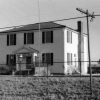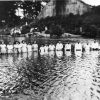calsfoundation@cals.org
Henry's Chapel
Henry’s Chapel was a log church built at Mound Prairie (Hempstead County) around 1817 by Methodist pioneers from Bellevue Valley, Missouri. Many accounts refer to Henry’s Chapel as the area’s first Protestant church.
In 1817, a Methodist conference appointed itinerant Methodist preacher William Stevenson to the Hot Springs Circuit, a wilderness area on the western frontier in what would later become southwest Arkansas. Stevenson had scouted the area in 1813 and realized the need to establish a church. He chose the tiny settlement of Mound Prairie as the place for it. At Stevenson’s urging, thirty families from the Bellevue Methodist Church moved to the area. The leader of the group was the Reverend John Henry, a thirty-eight-year-old preacher and farmer. Several others in the group were also preachers who would ride the circuit around Mound Prairie.
Upon arrival at Mound Prairie, Henry and the congregation immediately set to work to build a church made of hewed logs. After the completion of the church, many of the women and children lived in the church while the settlers staked their individual family homestead claims and began felling the timber necessary to construct their own cabins. They named their little church Mount Moriah, after the area where Solomon built the Temple. However, because neither surveys nor land ownership were certain in those early times, a competing claim of ownership caused the congregation to abandon the structure within a year of its completion. Another church site was located about a mile distant. Local shortleaf and loblolly pine trees were felled and cut to size for a structure that would be thirty-eight feet long by twenty-eight feet wide.
On one side, a cutout for the door was made facing the pulpit, with a window cut out behind the pulpit. A cutout was made for the fireplace at one end. The floor puncheons, slabs of split timber, were brought inside and laid. Wooden pegs were used only when necessary. Nails were not available. From inside the building, the peeled pine pole rafters and the shingles were visible, there being no ceiling. Thin puncheons were fastened to cross battens with wooden pins to form the double doors. They were hung on wooden hinges and closed to a center post. At the fireplace opening, the men laid a hearth of flat stones. Sticks and clay were mixed to form the chimney.
The split-log pews and the pulpit had been brought from the Mount Moriah church. They were refurbished before installation into the new church. A center railing to divide the men from the women during worship was also put into place, as was the mourner’s bench in front.
Henry had proved to be a worthy preacher. When the building was complete, the congregation named the new structure “Henry’s Chapel.” The area soon became a highly desirable one for settlement. In 1820, the Mound Prairie country was called the most densely populated part of Arkansas Territory, with well over 2,000 people settling there. For the next ten years, it was the state headquarters of Methodism. Henry served as local preacher, elder, and deacon in the district for fifty years, living to age ninety-three. His headstone can be found at Center Point Cemetery, a few miles from where Mound Prairie had been.
The rich black dirt of the Mound Prairie area proved difficult to farm because it contained too much clay, caking onto boots and wheels when it was wet. Farmers much preferred areas toward the south and east, especially Columbus (Hempstead County), where the soil contained more sand. John Henry moved to Center Point in 1846 when his daughter died to help take care of her family. He still served the chapel but had other duties all over his district. Likely, the chapel was eventually abandoned. Mound Prairie is now gone. A monument stands where the church was located; it is about five miles northwest of Washington (Hempstead County).
For additional information:
Anderson, James A. A Centennial History of Arkansas Methodism. Benton, AR: L. B. White Printing Co., 1935.
Vernon, Walter. Methodism in Arkansas, 1816–1976. Little Rock: Joint Commission for the History of Arkansas Methodism, 1976.
Williams, Charlean Moss. The Old Town Speaks: Recollections of Washington Hempstead County, Arkansas; Gateway to Texas, 1835, Confederate Capital, 1863. Houston: Anson Jones Press, 1951.
Stephen Henry
Fresno, California
 Architectural Styles
Architectural Styles Religion
Religion Henry's Chapel Marker
Henry's Chapel Marker 




Comments
No comments on this entry yet.